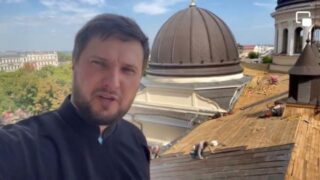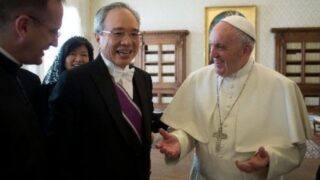The “Russian Orthodox Church of the Tsarist Empire” is part of a constellation of groups with some ten thousand followers.
by Massimo Introvigne


It was called, as is fashionable in Russia, a “special operation.” On February 14, a SWAT police team broke through the windows into a private residence, used as a church, in the village of Aibashi, in the Ulyanovsk Oblast, and arrested some forty persons. The aim of the special operation was to “destroy” a “cult” headed by one Leonid Vlasov, known to his followers as Father Zosima.
But what kind of “cult,” exactly? Police footage shows icons very similar to those one may find in a normal Russian Orthodox Church. Yet, Vlasov’s group, known as the Russian Orthodox Church of the Tsarist Empire (ROC-CI), has been for years a bête noire of Russian anti-cultists such as Alexander Dvorkin who regard it as an “apocalyptic cult led by an imposter.”


In fact, the ROC-CI is part of a cluster of groups that have at least ten thousand followers in Russia. They share with the Russian Orthodox Church (ROC) of Patriarch Kirill a nationalist approach to the history of Russia, a veneration for the last Tsar, Nicholas II Romanov (whom the ROC has canonized as a saint), and a willingness to acknowledge Stalin’s contribution to the greatness of Russia. However, they do not trust Putin’s government, hence Kirill’s support to it, and during the COVID-19 pandemic they refused to be vaccinated.
When the war of aggression against Ukraine started, they also refused to be conscripted and burned their passports and other ID documents not out of any support for Ukrainian independence—in fact, they firmly believe Ukraine is a part of Russia—but because they do not recognize Putin’s government as legitimate. They expect monarchy to be restored in Russia, and some groups have claimed that their leaders have Romanov blood in their veins and should be recognized as the new Tsars.
Although they attracted thousands of followers, the “Tsarist” communities did not attract much public attention until 2017, when the movie “Matilda” was released. It told the story of the famous Polish-Russian ballerina Mathilde Kschessinska and argued that, before becoming the lover of two Romanov Grand-Dukes, she had a three-year relationship with the future Tsar Nicholas II, which ended only when the latter married the future Empress Alexandra. The movie made it clear that the relationship was not platonic. Sex before the marriage is a sin for the Orthodox Church and conservative Orthodox called for banning the movie as disrespectful toward a canonized saint.


The “Tsarist” groups emerged as prominent protesters against “Matilda” and made national news when their rallies were joined by then Duma member from Russian-occupied Crimea Natalia Poklonskaya. It came out that Poklonskaya was a follower of Archimandrite Sergiy Romanov from Yekaterinburg, the most prominent leader of what was by now called the movement of the Tsarebozhniki (Tsar-worshippers). The problem was not only that Poklonskaya argued that whomever had watched “Matilda,” including prominent Russian political leaders, should be excommunicated. As the former senior prosecutor in the office of the Prosecutor General of Ukraine who had defected to Russia in 2014, Poklonskaya had been hailed as a hero by Putin’s United Russia party. “Matilda” or not, she has been appointed as an advisor to the Prosecutor General of Russia after the invasion of Ukraine in 2022.
Her spiritual father Sergiy Romanov, however, did not fare equally well. After he led a campaign against Patriarch Kirill and the government who had closed the churches during the pandemic, calling COVID-19 a Western invention, his convent was raided in December 2020. The archimandrite was arrested and sentenced in November 2021 to a jail term of three and a half years.


This was not, however, the end of the Tsarebozhniki. Several other groups existed as a loose network, and the one led by “Zosima” Vlasov in the Ulyanovsk Oblast emerged as the most popular thanks to its skilled use of social media. It was estimated that Vlasov reached an Internet audience of 150,000, although the active Tsarebozhniki of all persuasions were reduced to around 10,000 after the arrest of Romanov.
Vlasov is admittedly a controversial character. He was consecrated as a bishop by a Cyprus branch of the Russian Orthodox Church Abroad (a dissident part of the Russian Orthodox Church Outside Russia, which unlike the latter is not in communion with Moscow’s Russian Orthodox Church) and even anointed as Tsar of Russia.




Both Sergiy Romanov and Vlasov are ex-convicts who served time in jail for serious crimes before converting to conservative Christianity. While this is used as an argument against them by critics, they turned it on its head claiming they belong to an old Orthodox tradition of criminals-turned-saints whose prototype is Saint Moises the Ethiopian, the chief of a gang of bandits and murderers in 4th-century Egypt who converted and became an ascetic monk and priest.
Apart from being monarchists and advancing some extravagant claims for their leaders, the ideology of the Tsarebozhniki is not that different from Patriarch Kirill’s. The main difference is that they do not recognize Kirill’s authority and oppose Putin. They are arrested and prosecuted as “terrorists” and “Ukrainian agents.” But if they would supplement their veneration of Nicholas II and praise of Stalin with a support for Putin and his brutal war in Ukraine rather than arrested they will be rewarded with high offices, as happened with Poklonskaya. If there is something toxic in their beliefs, it comes from a poison spread by Kirill himself.









